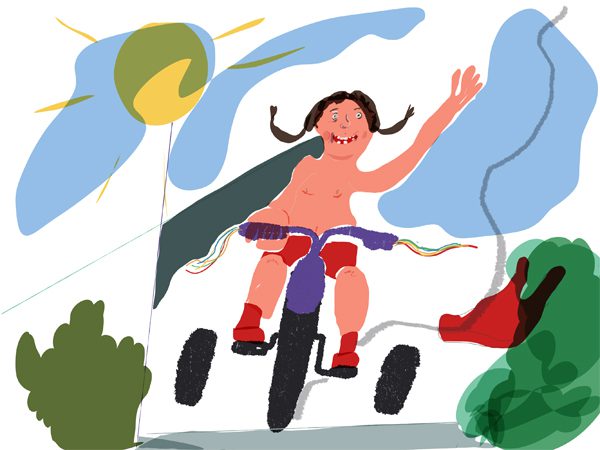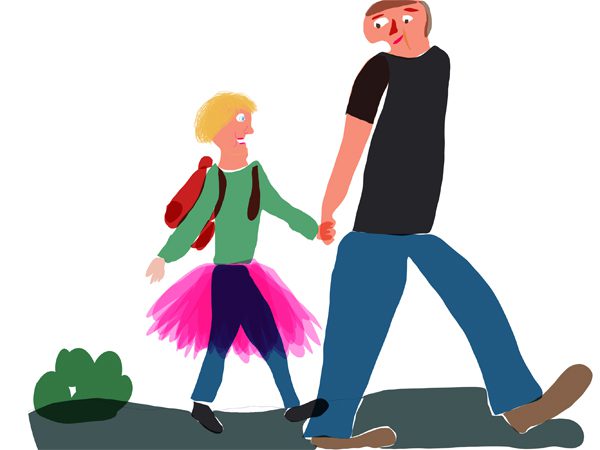When I was a little kid, I used to ride around my block shirtless on my Big Wheel—until one of the neighbors complained to my mom that it wasn’t appropriate. She made me wear a halter top, but I would ditch it behind some shrubs as soon as she was out of sight. I didn’t fit in, but perhaps as a concession to my desire to be “one of the boys,” she finally bought me a T-shirt that said, “I can beat up any boy on the block.” Needless to say, adolescence was a nightmare.
When my mom realized that hide and seek had given way to boy-girl parties, and Spin the Bottle to Seven Minutes in Heaven, she armed me with Teen Form bras, puffy sleeve shirts, and prairie skirts. She also offered me a perm and Sun-In, but Jovan was completely out of the question. Musk, like tampons, was strictly for sluts… Not that maintaining my feminine virtue was difficult. In sixth grade, I may have only weighed eighty pounds, but I had already broken the Kinsey Scale.
I finally found my tribe in college, and the outside world seemed to be changing, too. In my late twenties, I met a woman and we fell in love. We became domestically partnered, then civilly unioned, then Massachusetts married, and then eventually our marriage was recognized federally. We did many of the things “regular” people do, including having children.
Before I had kids of my own, I always thought I would raise them gender neutral, but in my experience that didn’t work. When I would have lunch with my friends who had daughters, their kids seemed perfectly happy to sit quietly and scribble away in their coloring books. My boys would immediately turn their crayons into projectiles.
When it came to video games, I tried to steer them toward the educational kind, encouraging them to shoot letters and numbers rather than humans. Despite my best intentions, they’d often receive “manly” gifts from well-meaning people who wanted to make sure the two-mom thing wasn’t stunting their masculinity.
At one point they had so many toy guns my wife and I organized a buy-back program. We also bought them a fuchsia tutu, adding it to the dress-up box alongside the firemen outfits and spacesuits. My oldest son took a liking to it, and started wearing it over his cis-gender clothing.
When he was about to start kindergarten, we’d heard that our neighborhood school was ranked among the best in the city. Our neighbors all agreed, yet mysteriously none sent their own kids there.
I figured out why pretty quickly. I couldn’t find my son at pickup on the first day of school. He’d been parked outside of his classroom in a canvas chair—a miniature replica of the kind that comes with a side arm pocket for your beer.
I learned that this “take a break” chair was only one of the school’s disciplinary mechanisms, doled out by non-teaching assistants known only by sobriquets like “Sensei” and “Mrs. M,” to manage the kids who were too loud, too fidgety, or just too bored to sit still and silent.
He learned virtually nothing in class, and compounding matters, he spontaneously decided to begin wearing his tutu every day. Walking him to school in the morning was a daily reenactment of my own childhood alienation, as the boys in his class stared at the both of us—the boy who dressed like a girl and his mom who looked like a boy.
I didn’t want to respond as my mother had responded to me—with a sartorial makeover designed to erase his difference and stifle his individuality. On the other hand, I didn’t want him to experience the alienation I felt as a kid, and felt again in these moments as an adult.
Had the school been fantastic, or even okay, my ambivalence about what to do would have been greater. But no matter what they’re wearing, any kid who’s spending most of his school days sitting outside of his classroom in a folding chair isn’t going to thrive. And my son’s time inside the classroom wasn’t much better.
With no options for a transfer in sight, my wife and I became desperate to get him into any private school that would offer us financial aid. Eventually he got an interview at a progressive school, and when I saw their reaction as he walked in wearing his tutu over his dress clothes, I knew he had a shot.
The whole car ride back to his home school, he talked excitedly about how much he loved the progressive school, and I was overwhelmed by a sense of relief—like maybe, just maybe things were going to work out.
When we arrived, his classroom was empty, and he remembered it was time for PE. He said he could walk himself to the gym, but I insisted on taking him. When I opened the door, all of the kids were sitting silently on the floor as Mrs. M patrolled the room from her folding chair.
A couple of the kids started pointing and laughing at us, and then more joined in. Their laughter started reverberating off the walls, and I began to feel like I was underwater. I wanted more than anything to protect my son. And I was having all kinds of terrible thoughts in my head, about handling the situation the way we used to when I was a kid, when slights—even perceived slights—were resolved with more than a warning on a T-shirt.
At that moment, Mrs. M suddenly screamed, “SHUT THE FUCK UP!!! DO YOU HEAR ME? SHUT THE FUCK UP!!! ALL OF YOU!!!”
Of course I was horrified. But I was also deeply grateful because she said exactly what I wanted to say and couldn’t. And, in fact, the kids did shut the fuck up.
From that day on, I never worried about my son’s physical safety. But I still worried about how his experiences at the school would shape his attitude about education, his self-concept, and how to deal with conflict. Sometimes sticking it out to be part of the solution is worth it, and sometimes the solution is to put your kid’s well-being over your politics.
The following year my son went to the progressive school. He thrived there socially and academically, and at some point he just stopped wearing the tutu. I didn’t ask him why he stopped just as I didn’t ask him why he started. Maybe the tutu was an expression of his individuality, but not necessarily his gender. Maybe he just grew out of it—literally. Or maybe he’ll revisit all of this again down the road.
The thing I’ve learned about kids is that you only ever get a glimpse of the grown-up people they’ll become. You can try and force them to conform to your value system, whatever that may be, or you can support them as they struggle to find their own way in the world. My son is in the fifth grade now, and he has only a vague recollection of what I just told you. And that’s totally okay. He’s his own person, just like his two moms.
***
Rumpus original art by Liam Golden.






